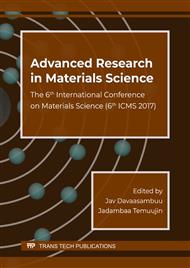p.1
p.9
p.18
p.23
p.28
p.34
p.40
p.47
Synthesis, Structure and Electronic Properties of Li4Ti5O12 Anode Material for Lithium Ion Batteries
Abstract:
Nanosized spinel Li4Ti5O12 was successfully synthesized by a solid state reaction method at 800°C according to the Li4Ti5O12 cubic spinel phase structure. In this synthesizing process, anatase TiO2 and Li2CO3 were used as reactants. The average grain size of the synthesized powders was around 200 nm. The synthesized Li4Ti5O12 powder was characterized X-ray Diffraction (XRD), X-ray Photoelectron Spectroscopy (XPS), Scanning Electron Microscopy (SEM), Energy Dispersive X-ray spectrometry (EDS), and Specific Surface Area Analyzer (BET, Brunner-Emmett-Teller) respectively. X-ray diffraction results show that calcination temperature and time have the important effects on the crystal structure of Li4Ti5O12 powder. In this study, we used a first principle method, based on the density functional theory to explore electronic and structural properties of Li4Ti5O12, as anode material for lithium ion batteries. Differences on these properties between delithiation state Li4Ti5O12 and lithiation state Li7Ti5O12 are compared. All the predicted structural and electrochemical properties agree closely with the experimental findings in literature. The average intercalation voltage of 1.4V during charging/discharging were obtained. We have shown that the Li4Ti5O12 material exhibits insulating behavior with the band gap of 3.16 and 3.90 eV using the GGA and GGA+U+J0 calculations respectively. Li7Ti5O12 becomes metallic as Li atoms inserted in Li4Ti5O12 material. Spinel Li4Ti5O12 has been regarded as an attractive anode material for the development of high-power lithium-ion batteries because of its unique attributes of high safety and rate capability.
Info:
Periodical:
Pages:
9-17
Citation:
Online since:
January 2018
Price:
Сopyright:
© 2018 Trans Tech Publications Ltd. All Rights Reserved
Share:
Citation:


